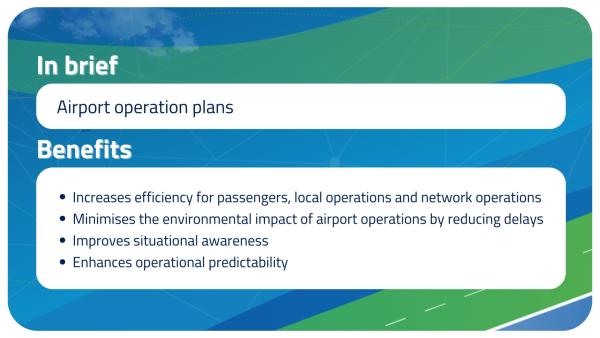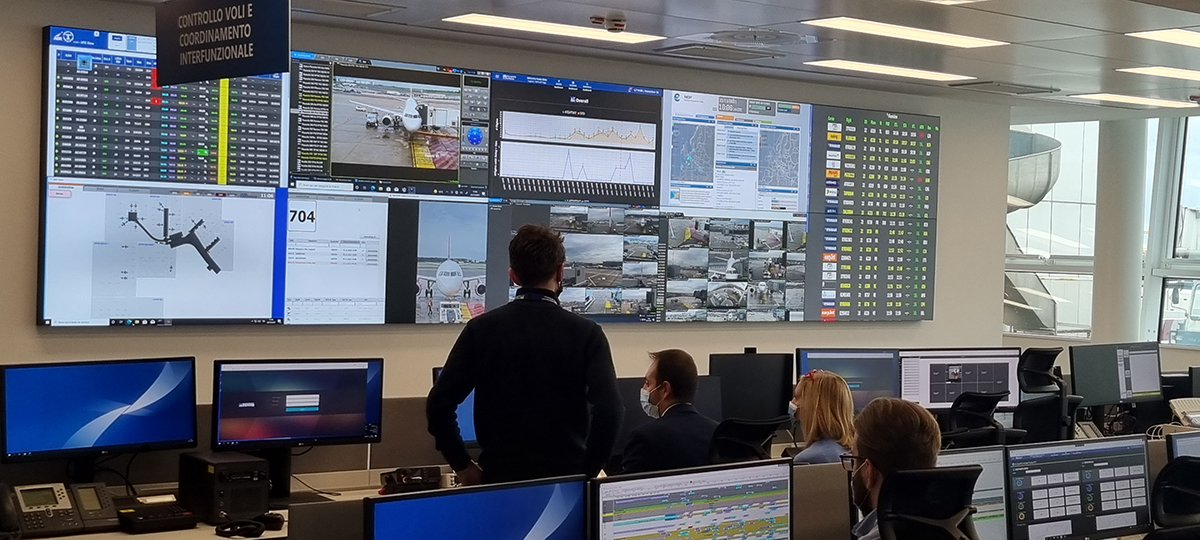Helping airports improve the efficiency of their operations
SESAR supports the rollout of airport operation plans that promote safety, communication and collaboration.
With SESAR’s support, many European airports have designed and implemented an airport operations plan – a collaboratively agreed upon, rolling plan that is continually updated and enriched with new information. By harnessing real-time information sharing between airport stakeholders, these plans help make airport operations more efficient.

A critical consideration for airports is how to best manage their infrastructure so that passengers experience safe and smooth journeys. Doing this requires establishing a shared understanding of the situation on the ground (and in the air), allowing all stakeholders to make informed decisions that lead to the smoothest possible airport operations.
That shared understanding starts with an airport operations plan (AOP) that coordinates the efforts of all service providers, such as airlines, air navigation service providers, ground handlers, security companies and others who have a direct input on overall airport operations and ensures the integration between the airport and the network.
The solution
A concept defined and developed by SESAR(1), an AOP is implemented in two stages: initial AOP (iAOP) and extended AOP. The iAOP focuses on the short-term planning and execution phase and paves the way to the subsequent extended AOP, which incorporates the landside operation. Both phases contribute to greater integration between the individual airport and the wider network.
With an iAOP, an airport can expect to achieve:
- Optimised airport operations, resulting in improved planning, information-sharing and interaction with the network.
- Enhanced operational decisions, leading to optimised departure surface and arrival management.
- Implementation of information-sharing to optimise airport resources data, flight trajectory data and local weather data.
By incorporating the landside operation, an extended AOP increases the scope beyond the airside operating environment and addresses processes that have an impact on flight predictability and efficiency.
The SESAR AOP solution has two principal purposes, to stablish appropriate performance goals and to monitor performance during the execution timeframe.
The end goal of the AOP is the full integration with the network operations plan (NOP). Once implemented, the EUROCONTROL Network Manager can offer direct, open and consolidated support through an efficient partnership approach, from planning to operations. A direct link can then be ensured between network capacity planning, airspace improvements, updated airport planning, integrated data and tool availability for all planning phases, and enhanced air traffic flow and capacity management (ATFCM), as well as for the planning and coordination of significant events.
The results
Enhancing safety, efficiency and coordination within airport operations are the key benefits offered by the AOP. For example, coordinating the operations of all airport stakeholders increases efficiency for passengers and local and network operations. It also helps minimise the environmental impact of airport operations by reducing delays, all while maintaining safe operations and improving situational awareness.
Furthermore, thanks to the up-to-the-minute information sharing facilitated by the AOP, every operational stakeholder at a particular airport can access changes in scheduling, operating conditions and circumstances, allowing for better, more proactive performance management by everyone. This ultimately makes operations run smoother and more efficiently.
With an AOP, airports experience enhanced operational predictability, particularly in degraded situations like poor weather, runway closures, etc.
By 2030, the implementation of the iAOP, synchronised and coordinated through SESAR deployment according to the Common Project 1 EU Regulation, will lead to savings of more than 2.7 million minutes of flight time, more than 100,000 tonnes of fuel and almost 324,000 tonnes of CO2.
The details
- Alignment between planned and actual airport operations is continuously monitored, with changes being made to the AOP as required. As stakeholders update their intentions, or accurate flight progress information is received, the AOP is refined and used to manage resources and coordinate operations.
- SESAR’s aim is to provide the necessary processes and tools for maintaining airport performance in all operating conditions, and to facilitate information sharing within the wider network.
- Adopting an AOP reflects the operational status of the airport, thereby facilitating demand and capacity balancing. It connects the relevant stakeholders, notably the airspace users’ flight operations centre.
APOC and AOP
All major airports in Europe manage their daily airport operations via an airport operations centre (APOC), which can be a physical facility or a virtual collaboration between stakeholders. The APOC serves as the platform for stakeholder communication and coordination, based on shared knowledge, and is the essential link between the airport and the ATM network manager.
Ultimately, the AOP and APOCs make airports more resilient to disruptions like adverse weather conditions by enhancing the common situational awareness of ATM stakeholders through the sharing of real-time information.
With SESAR’s support, a number of APOCs have been established in recent years, including at Schiphol Airport(2), Brussels Airport(3), Orly Airport(4) and Rome Fiumicino(5).
In action
In 2017, Brussels Airport partnered with 11 other airports and two air navigation service providers to develop an iAOP at each airport in a harmonised way. The participating airports were: Aéroports de la Côte d‘Azur, Aéroports de Paris, Aeroporti di Roma, Brussels airport, Copenhagen airport, Dublin airport, ENAV S.p.A, Munich airport, Frankfurt airport, Manchester airport, SEA Milan Airports, London Stansted airport, Skeyes and Stockholm Arlanda airport(6).
Thanks in part to initiatives like this, by the end of 2024, 17 out of 19 European airports listed in the geographical scope of the EU Common Project 1 Regulation will have successfully implemented an iAOP.

References
- Airport operations plan (AOP) and its seamless integration with the network operations plan (NOP)
- Amsterdam Airport Schiphol - Airport Operations Centre
- Projects - APOC implementation | SESAR DM
- SESAR Deployment Manager – Projects – Initial AirPort Operational Centre (iAPOC) | SESAR DM
- Aeroporti di Roma's commitments to SESAR projects
- Synchronised stakeholder decision on process optimization at airport level

